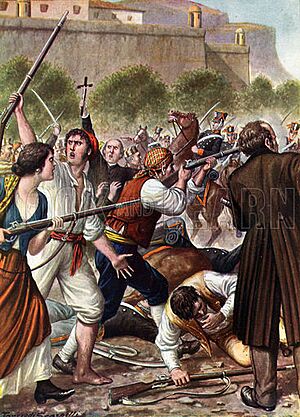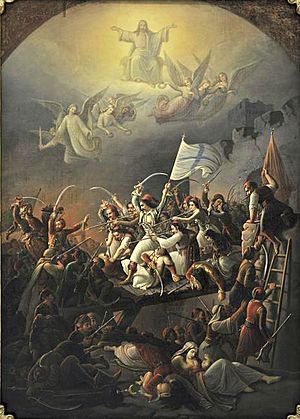Revolutions during the 1820s facts for kids
Imagine a time when people across Europe wanted more say in how their countries were run! The Revolutions of the 1820s were a series of big changes and uprisings. People in places like Russia, Spain, Portugal, and parts of Italy fought for new governments. They wanted their kings to share power and follow a constitution. Meanwhile, in Greece, people fought for their freedom from the Ottoman Empire. These revolts mostly happened in the outer parts of Europe, unlike later big revolutions.
Contents
Timeline of Key Events
- 1820: The Three Liberal Years begin in Spain.
- 1820: The Liberal Revolution starts in Portugal.
- 1820: A revolution begins in the Kingdom of the Two Sicilies (part of Italy).
- 1821 – 1829: The Greek War of Independence takes place.
- 1821: A revolution happens in the Kingdom of Sardinia (another part of Italy).
- 1825: The Decembrist revolt breaks out in Russia.
- 1828: The Decembrist revolution occurs in Argentina.
Revolutions in Europe
What Happened in Italy?

The 1820 revolution started in Sicily and Naples, which were part of the Kingdom of the Two Sicilies. People were unhappy with King Ferdinand I of the Two Sicilies. They forced him to agree to a new constitution, meaning he would share power.
This success inspired a secret group called the Carbonari in northern Italy. They also started revolts. In 1821, in the Kingdom of Sardinia (also called Piedmont), King Victor Emmanuel I had to step down. For a short time, this area also gained a constitution and other liberal changes thanks to the Carbonari.
However, powerful countries like Austria, Russia, and Prussia, known as the Holy Alliance, did not like these changes. They decided to stop the revolutions. In February 1821, an army was sent to Naples to crush the revolt. The new King of Sardinia also asked for Austrian help. The Carbonari revolts quickly ended, and their leaders had to flee the country.
Spain's Fight for a Constitution
In Spain, a military officer named Colonel Rafael del Riego led a large part of the army in a protest. They demanded that the liberal Constitution of 1812 be brought back. King Ferdinand VII agreed, but he secretly asked for help from other European powers.
At a meeting in 1822, called the Congress of Verona, it was decided that France would send 100,000 soldiers to Spain. These French troops quickly defeated Riego's forces. The king then took back all his power, ending the period known as the Trienio Liberal (meaning "Three Liberal Years").
Portugal's Liberal Revolution
The Liberal Revolution of 1820 began with a military uprising in the city of Porto, in northern Portugal. This revolt quickly and peacefully spread across the country.
One big result was that the Portuguese royal family returned home in 1821. They had been living in Brazil since fleeing Portugal during the Peninsular War (a war against Napoleon). This revolution also started a time when Portugal had a constitution. The 1822 Constitution was approved and put into action.
Interestingly, Brazil had become very strong and independent while the royal family was there. This meant that in 1820, it was Portugal that declared its independence from Brazil, not the other way around! Brazil then declared its own independence from Portugal later.
Greece's Struggle for Freedom

The Greek War of Independence was a successful fight for freedom by Greek revolutionaries. They fought against the powerful Ottoman Empire from 1821 to 1829. Greeks in the 19th century simply called it the "Struggle."
Later, countries like Britain, France, and Russia helped the Greeks. The Ottomans received help from their allies in North Africa. This war led to the creation of modern Greece as an independent country. Greeks around the world celebrate their independence day on March 25th.
The Decembrist Revolt in Russia
The Decembrist revolt happened in Imperial Russia on December 26, 1825. Officers in the Russian army led about 3,000 soldiers. They refused to accept Nicholas I as the new Emperor. This was because Nicholas's older brother, Constantine, had secretly given up his right to the throne.
Because these events took place in December, the rebels became known as the Decembrists. Their uprising was quickly put down.
Revolutions in Latin America
Argentina's Decembrist Revolution
The Decembrist revolution in Argentina was a military takeover in the Buenos Aires Province. Juan Lavalle, a military leader returning from a war, led a coup on December 1, 1828. He captured and killed the governor, Manuel Dorrego, and closed the government.
However, a rancher named Juan Manuel de Rosas organized local fighters. They fought against Lavalle and removed him from power, bringing back the government. This coup started the Argentine Civil Wars. Rosas was then made governor to lead the fight against another group called the Unitarian League. The conflict continued for some time.


